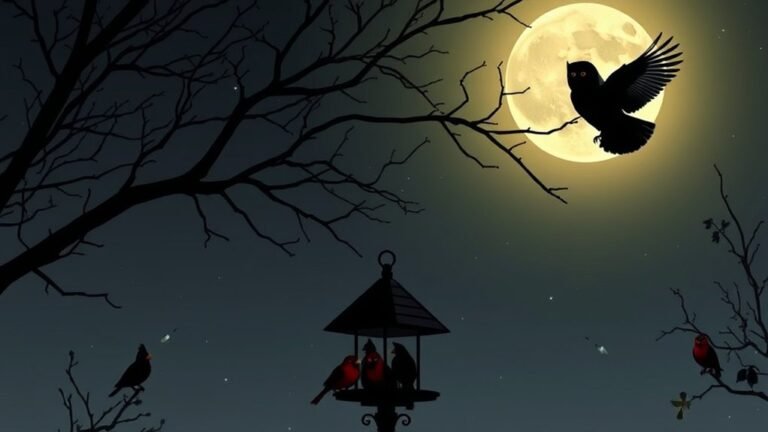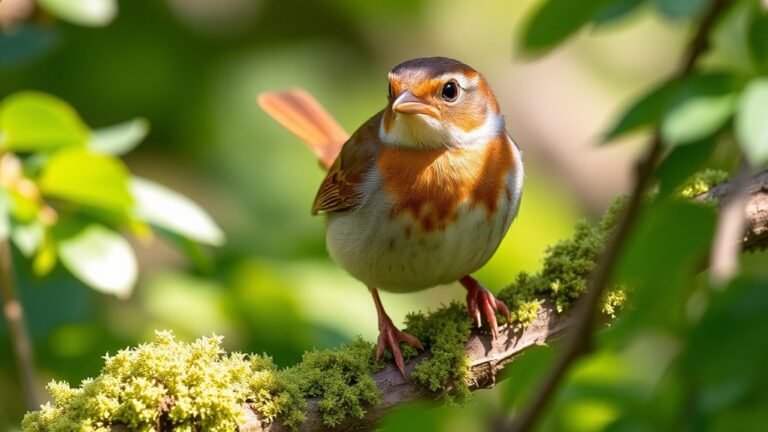Birds That Fly at Night Like Bats: Crepuscular and Nocturnal Flyers
Many birds fly at night, similar to bats. These birds are known as crepuscular or nocturnal flyers. They have special adaptations that help them move and hunt in low-light conditions. Their vision and hearing are both very sharp, allowing them to find food and navigate through the dark.
These birds play important roles in their ecosystems. They help control insect populations and spread seeds. As their habitats change, their survival becomes uncertain. Understanding their behaviors and needs is crucial as we work to protect them and their environments.
Key Takeaways
Crepuscular birds, like the American woodcock, are active at twilight. Nocturnal birds, such as owls, thrive in darkness. These night-flying birds have adaptations that help them see well at night. Some use echolocation for hunting and finding their way in low light.
Silent flight is vital for these birds. Owls have special feathers that reduce noise, allowing them to hunt stealthily. Nocturnal species, like night hawks, hunt effectively. They use their sharp hearing and natural camouflage to stay hidden from prey.
Night birds play an important ecological role. They help control pest populations and maintain biodiversity in their environments.
Understanding Crepuscular and Nocturnal Birds
Many people think birds are active mostly during the day. However, crepuscular and nocturnal birds show different behaviors suited to low light conditions.
Crepuscular birds, such as the American woodcock, are active during dusk and dawn. They use the dim light to find food and communicate with others. Their eyes are adapted for low light, helping them see well in the twilight.
Their calls also change in volume and tone to suit the quieter atmosphere, making these times ideal for mating.
Nocturnal birds, like owls, are awake at night. They've sharp hearing and excellent night vision, which help them hunt in the dark.
Watching these birds can increase your understanding of their behaviors and adaptations. This knowledge deepens your appreciation for the variety of bird life that exists after sunset.
Unique Adaptations for Night Flight
As night arrives, many birds show special adaptations for flying in low light. One key feature is their excellent night vision, which helps them see clearly in darkness. This ability comes from having more rod cells in their eyes, improving their light sensitivity.
Additionally, some birds can use echolocation, similar to bats. They create sounds and listen for the echoes that bounce back. This skill helps them detect obstacles and find food effectively.
These adaptations combine sight and sound, making night flying a fascinating experience for birds.
Hunting Techniques of Night-Flying Birds
When night falls, night-flying birds use different hunting techniques to catch prey in the dark. These birds often move silently, gliding smoothly to avoid making noise and alerting their prey. Many have excellent eyesight and hearing, allowing them to notice even the slightest movement in the bushes.
They use quick movements, darting between branches or making sudden drops to catch insects or small mammals. By changing their flight patterns and using camouflage, these birds blend into the night, improving their chances of success.
Observing their behaviors shows how these nocturnal hunters adapt and thrive in the dark.
Notable Species of Nocturnal Flyers
Nocturnal flyers include many unique species that thrive in darkness. Notable among these are owls, like the Great Horned Owl and the Barn Owl. They've excellent night vision and hearing, which helps them hunt silently.
Their feathers are structured to reduce noise, allowing them to glide smoothly through the night.
Night hawks are another type of nocturnal flyer. They skillfully hunt insects in low light while flying. These birds demonstrate fascinating adaptations for survival.
If you watch carefully, you might see them during their nighttime activities.
The Ecological Impact of Night Birds
Night birds play an important role in nature.
They're vital to night ecosystems and affect local food webs. By eating nocturnal insects and small mammals, these birds help control pest populations. This protects crops and limits disease spread.
Their hunting skills allow them to occupy spaces that daytime birds cannot, which helps increase biodiversity. Night birds also compete with other nocturnal hunters, which maintains a balanced relationship between predators and prey.
Recognizing the value of these birds helps us understand their role in preserving the balance of nature. They connect various organisms in our environment.
Comparison Between Daytime and Nighttime Avian Behavior
Daytime and nighttime birds behave differently based on their environments, but they share basic instincts.
Diurnal birds, which are active during the day, forage in bright light. This helps them see food and avoid predators. Many of these birds migrate long distances to find food during different seasons.
Nocturnal birds, active at night, have special adaptations like good night vision and strong hearing. They hunt and move around in the dark.
These birds often stay active when daytime birds are resting, which helps them avoid competition.
Both daytime and nighttime birds showcase the diversity of bird life and their shared strategies for survival in nature.
The Future of Night-Flying Birds in Changing Environments
As nocturnal birds face changes in their habitats due to climate change, urbanization, and habitat loss, their methods for survival may change too. These birds often adapt by shifting their locations or changing their behaviors.
In urban areas, they alter their foraging and breeding practices.
To protect these birds, conservation efforts must focus on preserving important nighttime habitats and reducing light pollution, which affects their natural behaviors. Getting local communities involved in conservation can increase the chances of these birds thriving.
By enhancing biodiversity and restoring their environments, we can support night-flying birds.
Your awareness and actions can help these unique birds thrive in their changing habitats. By understanding their needs and supporting conservation efforts, you contribute to their survival in a challenging environment.
Frequently Asked Questions
What Distinguishes Crepuscular Birds From Fully Nocturnal Species?
Crepuscular birds are active during twilight. They use their vision to see well in low light. These birds can detect movement and changes in their environment effectively.
In contrast, fully nocturnal birds are adapted for complete darkness. They possess enhanced night vision and other special features to help them hunt and navigate in the dark.
While crepuscular birds rely on reduced light, fully nocturnal species thrive in total darkness. This difference sets them apart in behavior and adaptations.
How Do Night-Flying Birds Navigate in Complete Darkness?
Night-flying birds move skillfully in darkness. They use enhanced night vision to see better at night. Some birds also use echolocation to find their way. These birds have special features that help them spot prey and avoid obstacles. This allows them to move accurately in their nighttime habitats.
Do Nocturnal Birds Have Different Breeding Behaviors Compared to Daytime Birds?
Nocturnal birds have distinct breeding behaviors compared to daytime birds. They use specific courtship displays that are suitable for low-light conditions. These behaviors are adapted to nighttime environments. This adaptation helps ensure successful reproduction. In contrast, diurnal birds have their own set of breeding strategies that align with daytime activities. Overall, the breeding behaviors of these two groups reflect their environmental needs and challenges.
What Is the Role of Moonlight for Nocturnal Bird Activity?
Moonlight affects nocturnal birds in several ways. It helps them find food and choose mates. During the full moon, the light makes it easier for birds to see. However, the brightness can also expose them to predators. Additionally, artificial light pollution can disrupt their natural behaviors, complicating their daily lives. Understanding these factors is crucial for wildlife conservation and bird watchers alike.
Can Human Activities Disrupt the Hunting Patterns of Night-Flying Birds?
Human activities disrupt the hunting patterns of night-flying birds. Light pollution affects how they find their way. It can lead to confusion and make it hard for them to hunt. Habitat destruction takes away their homes and food sources. This directly impacts their survival. You can help by supporting efforts for darker skies and protecting natural habitats.

Ava is a bird enthusiast and nature lover who has spent countless hours observing and learning about the fascinating world of birds. With a passion for sharing her knowledge and inspiring others to appreciate the beauty of birds, Ava writes about her experiences and insights on avianadmirer.com.







